Chapter 4: Types of cost and cost behaviour
Chapter learning objectives
Upon completion of this chapter you will be able to:
- explain and illustrate production and non-production costs
- describe the different elements of production cost – materials, labour and overheads
- describe the different elements of non-production cost – administrative, selling, distribution and finance
- explain the importance of the distinction between production and non-production costs when valuing output and inventories
- explain and illustrate with examples classifications used in the analysis of the product/service costs including by function, direct and indirect, fixed and variable, stepped fixed and semi variable costs
- explain and illustrate the concepts of cost objects, cost units and cost centres
- describe and illustrate, graphically, different types of cost behaviour
- use high/low analysis to separate the fixed and variable elements of total costs including situations involving semi variable and stepped fixed costs and changes in the variable cost per unit
- explain the advantages and disadvantages of using high low method to estimate the fixed and variable element of costing
- explain the structure of linear functions and equations
- explain and illustrate the use of codes in categorising transaction.

1 Production and non-production costs
Classifying costs
Costs can be classified in a number of different ways.
- Element – costs are classified as materials, labour or expenses (overheads).
- Nature – costs are classified as being direct or indirect.
- Behaviour – costs are classified as being fixed, variable, semi-variable or stepped fixed.
- Function – costs are classified as being production or non-production costs.
Classification by element
The main cost elements that you need to know about are materials, labour and expenses.
- Materials – all costs of materials purchased for production or non-production activities. For example, raw materials, components, cleaning materials, maintenance materials and stationery.
- Labour costs – all staff costs relating to employees on the payroll of the organisation.
- Expenses – all other costs which are not materials or labour. This includes all bought-in services, for example, rent, telephone, sub-contractors and costs such as the depreciation of equipment.
Classification by function – production costs
Production costs are the costs which are incurred when rawmaterials are converted into finished goods and part-finished goods(work in progress).

 Examples of production costs
Examples of production costs
- Direct materials – the direct materials that go into making a product. For example, cloth in the manufacture of shirts.
- Direct labour – the cost of labour directly engaged in making a product. For example, the wages of the machinists making the shirts.
- Direct expenses – the cost of expenses directly involved in making a product. For example, the royalties paid to a designer, or the freight charges for special materials used to make the shirts.
- Variable production overheads – overheads that vary in direct proportion to the quantity of product manufactured. For example, code of fuel used to run machinery.
- Fixed production overheads – overheads that are fixed whatever the quantity of product manufactured. For example, rent of the factory.

Classification by function – non-production costs
Non-production costs are costs that are not directly associated with the production processes in a manufacturing organisation.

 Examples of non-production costs
Examples of non-production costs
- Administrative costs – the costs involved in running the general administration departments of an organisation, for example, the accounts department.
- Selling costs – costs associated with taking orders from customers who wish to buy an organisation's products (sales department costs) and also marketing costs.
- Distribution costs – the costs involved in distributing an organisation's finished products, such as the cost of running the warehouse or delivery costs.
- Finance costs – the costs that are incurred in order to finance an organisation, for example, loan interest.

Distinguishing between production and non-production costs
Once costs have been analysed as being production or non-productioncosts, management may wish to collect the costs together on a costcard. A cost card (or unit cost card) lists out all of the costsinvolved in making one unit of a product.
COST CARD – statement of the total cost of one unit of a product
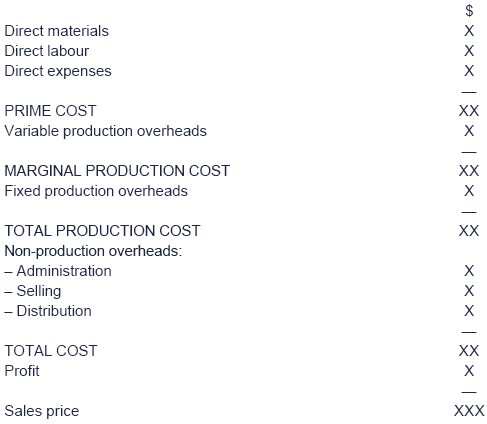

 Understanding a cost card
Understanding a cost card
- The total production cost is the marginal production cost (total direct costs) plus any fixed production overheads.
- It is important that the total production cost of a product is clearly identified as being such. Non-production costs must be analysed separately.
- This is because when finished products are transferred to the warehouse as finished goods, they are transferred at a value that reflects the direct manufacturing costs that were involved in producing them, i.e. total production cost.
- When finished goods are transferred to the warehouse, this is where they remain until they are sold to customers or held as inventory.
- When inventory is sold, it is important that it is given a value that reflects the 'cost of sale' of the product, so that a profit can be calculated and reported in the income statement.
- Similarly, at the end of an accounting period, inventory is valued and reported in the balance sheet of an organisation at its total production cost.
- It is important, therefore, that the production costs and the non-production costs are clearly distinguished for the purposes of valuing output and inventories.


 Test your understanding 1
Test your understanding 1

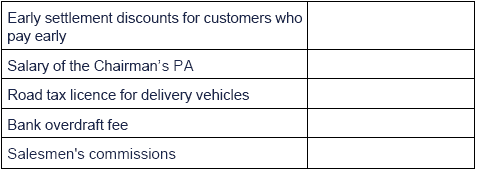
Complete the following table by classifying each expense correctly.
Classifications
(1) = Production
(2) = Selling
(3) = Distribution
(4) = Administrative
(5) = Finance

2 Direct and indirect costs
Direct costs
 Direct costs are costs which can be directly identified with a specificcost unit or cost centre. There are three main types of direct cost:
Direct costs are costs which can be directly identified with a specificcost unit or cost centre. There are three main types of direct cost:
- direct materials – for example, cloth for making shirts
- direct labour – for example, the wages of the workers stitching the cloth to make the shirts
- direct expenses – for example, the royalties paid to a designer, or the freight charges for imported special materials.
The total of direct costs is known as the prime cost.
Indirect costs
 Indirect costs are costs which cannot be directly identified with aspecific cost unit or cost centre. Examples of indirect costs includethe following:
Indirect costs are costs which cannot be directly identified with aspecific cost unit or cost centre. Examples of indirect costs includethe following:
- indirect materials – these include materials that cannot be traced to an individual shirt, for example, cotton
- indirect labour – for example, the cost of a supervisor who supervises the shirt makers
- indirect expenses – for example, the cost of renting the factory where the shirts are manufactured.
The total of indirect costs is known as overheads.

 Test your understanding 2
Test your understanding 2
Identify whether the following costs are materials, labour or expenses and whether they are direct or indirect.
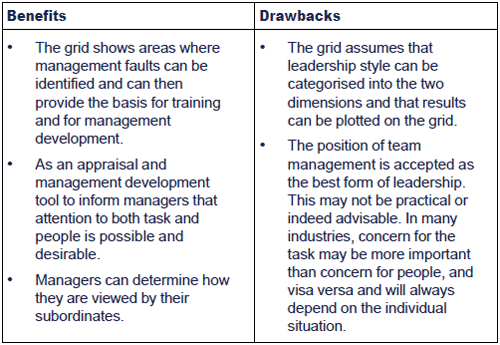


 Test your understanding 3
Test your understanding 3
(a) Which of the following would be classed as indirect labour?
A Assembly workers
B A stores assistant in a factory store
C Plasterers in a building company
D An audit clerk in an accountancy firm
(b) Direct costs are:
A costs which can be identified with a cost centre but not a single cost unit
B costs which can be identified with a single cost unit or cost centre
C costs which can be attributed to an accounting period
D none of the above.

3 Fixed and variable costs
Cost behaviour
Costs may be classified according to the way that they behave. Costbehaviour is the way in which input costs vary with different levels ofactivity. Cost behaviour tends to classify costs as one of thefollowing:
- variable cost
- fixed cost
- stepped fixed cost
- semi-variable cost.
Variable costs
 Variable costs are costs that tend to vary in total with the level ofactivity. As activity levels increase then total variable costs willalso increase.
Variable costs are costs that tend to vary in total with the level ofactivity. As activity levels increase then total variable costs willalso increase.
- Variable costs can be shown graphically as follows:
- Note that as total costs increase with activity levels, the cost per unit of variable costs remains constant.
- Examples of variable costs include direct costs such as raw materials and direct labour.
Fixed costs
A fixed cost is a cost which is incurred for an accounting period, and which, within certain activity levels remains constant.
Fixed costs can be shown graphically as follows:
- Note that the total cost remains constant over a given level of activity but that the cost per unit falls as the level of activity increases.
- Examples of fixed costs:
- rent
- business rates
- executive salaries.

 Numerical illustration of graph shapes
Numerical illustration of graph shapes
- If factory rent is $5,000 per month, this cost will be incurred whether 2 widgets are made, or 200 widgets are made – graph 1 demonstrates this.
- If 2 widgets are made the fixed cost per unit is $5,000 ÷ 2 , i.e. $2,500 per widget.
- If 200 widgets are made the fixed cost per unit is $5,000 ÷ 200, i.e. $25 per widget.
- Therefore, the fixed cost per unit falls at a reducing rate but never reaches zero – graph 2 demonstrates this.

Stepped fixed costs
 This is a type of fixed cost that is only fixed within certain levelsof activity. Once the upper limit of an activity level is reached then anew higher level of fixed cost becomes relevant.
This is a type of fixed cost that is only fixed within certain levelsof activity. Once the upper limit of an activity level is reached then anew higher level of fixed cost becomes relevant.
- Stepped fixed costs can be shown graphically as follows:
- Examples of stepped fixed costs:
- warehousing costs (as more space is required, more warehouses must be purchased or rented)
- supervisors' wages (as the number of employees increases, more supervisors are required).

 Numerical example of stepped costs
Numerical example of stepped costs
- For production of up to 50 widgets, only one supervisor is required but if production is between 50 and 100 widgets, two supervisors are required.
- The cost of one supervisor is $18,000 per annum and the cost of two supervisors is therefore $36,000.
- The fixed costs therefore increase in steps as shown in the stepped fixed cost graph above.

Semi-variable costs
 Semi-variable costs contain both fixed and variable cost elements andare therefore partly affected by fluctuations in the level of activity.
Semi-variable costs contain both fixed and variable cost elements andare therefore partly affected by fluctuations in the level of activity.
- Semi-variable costs can be shown graphically as follows:
- Examples of semi-variable costs:
- electricity bills (fixed standing charge plus variable cost per unit of electricity consumed)
- telephone bills (fixed line rental plus variable cost per call)

 Test your understanding 4
Test your understanding 4
Classify the following items of expenditure according to theirbehaviour i.e. as fixed, variable, semi-variable or stepped fixed costs.



 Test your understanding 5
Test your understanding 5
Study the following graphs, where the vertical axis represents'Total Costs' or 'Cost per unit'. Then answer the questions shown below.


4 Analysis of costs into fixed and variable elements
Cost estimation
A number of methods exist for analysing semi-variable costs into their fixed and variable elements. The two main methods are:
- high/low method
- least squares regression – (we will look at this in the next chapter).
High/low method
- Step 1 – select the highest and lowest activity levels, and their associated costs. (Note: do not take the highest and lowest costs)
- Step 2 – find the variable cost per unit
- Step 3 – find the fixed cost by substitution, using either the high or low activity level.
- Fixed cost = Total cost at activity level – Total variable cost

 Assumptions underlying the high/low method
Assumptions underlying the high/low method
Assumptions of the high/low method are as follows:
- the cost under consideration is potentially semi-variable (i.e. it has both fixed and variable elements)
- the linear model of cost behaviour is valid i.e. y = a + bx (we will study this in more detail later on in this chapter).
Making a distinction between fixed and variable costs might be used:
- in product costing
- to analyse profitability of a product or department
- to help managers to make decisions about increasing/decreasing activity levels
- to estimate future costs (forecasting and budgeting)
- to estimate what costs should have been (for budgetary control and performance assessment).


 Illustration 1 – Analysis of costs into fixed and variable elements
Illustration 1 – Analysis of costs into fixed and variable elements
Required:
(a) Find the variable cost per unit.
(b) Find the total fixed cost.
(c) Estimate the total cost if output is 350 units.
(d) Estimate the total cost if output is 600 units.


 Solution
Solution
Solution
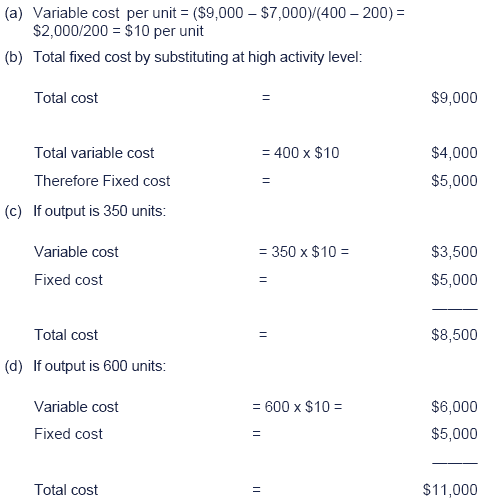


 Test your understanding 6
Test your understanding 6
The total costs incurred at various output levels in a factory have been measured as follows:
Required:
Using the high/low method, analyse the total cost into fixed and variable components.

High/low method with stepped fixed costs
Sometimes fixed costs are only fixed within certain levels ofactivity and increase in steps as activity increases (i.e. they arestepped fixed costs).
- The high/low method can still be used to estimate fixed and variable costs.
- Adjustments need to be made for the fixed costs based on the activity level under consideration.

 Illustration 2 – Analysis of costs into fixed and variable elements
Illustration 2 – Analysis of costs into fixed and variable elements
An organisation has the following total costs at three activity levels:

Variable cost per unit is constant within this activity range andthere is a step up of 10% in the total fixed costs when the activitylevel exceeds 5,500 units.
What is the total cost at an activity level of 5,000 units?
A $44,000
B $44,800
C $45,400
D $46,800


 Solution
Solution
A
Calculate the variable cost per unit by comparing two output levels where fixed costs will be the same:
Variable cost per unit = [(54,800 – 50,000) ÷ (7,500 – 6,000)] = $3.20
Total fixed cost above 5,500 units = [54,800 – (7,500 x 3.20)] = $30,800
Total fixed cost below 5,500 units = 30,800/110 × 100 = $28,000
Total cost for 5,000 units = [(5,000 x 3.20) + 28,000] = $44,000

High/low method with changes in the variable cost per unit
Sometimes there may be changes in the variable cost per unit, andthe high/low method can still be used to determine the fixed andvariable elements of semi-variable costs. The variable cost per unit maychange because:
- prices may be forecast to increase in future periods

 Illustration 3 – Analysis of costs into fixed and variable elements
Illustration 3 – Analysis of costs into fixed and variable elements
The following information relates to the manufacture of Product LL in 20X8:
For output volumes above 350 units the variable cost per unit fallsby 10%. (Note: this fall applies to all units – not just the excessabove 350).
Required:
Estimate the cost of producing 450 units of Product LL in 20X9.


 Solution
Solution
Solution
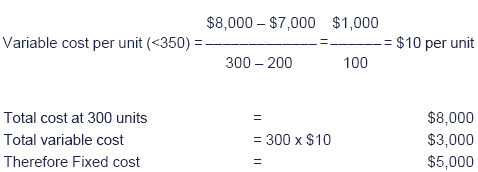
If output is 450 units in 20X9:

(W1) Variable cost per unit in 20X9 (when output > 350 units) = $10 x 0.9 = $9 per unit


 Test your understanding 7
Test your understanding 7
The total costs incurred in 20X3 at various output levels in a factory have been measured as follows:
When output is 80 units or more, another factory unit must be rented and fixed costs therefore increase by 100%.
Variable cost per unit is forecast to rise by 10% in 20X4.
Required:
Calculate the estimated total costs of producing 100 units in 20X4.


 Advantages and limitations of high/low
Advantages and limitations of high/low
The main advantage of the high/low method is that it is easy to understand and easy to use.
The limitations of the high/low method are as follows:
- it relies on historical cost data and assumes this data can reliably predict future costs
- it assumes that activity levels are the only factor affecting costs
- it uses only two values (highest and lowest) to predict future costs and these results may be distorted because of random variations which may have occurred.
- bulk discounts may be available for purchasing resources in large quantities.

5 Cost equations
Equation of a straight line
The equation of a straight line is a linear function and is represented by the following equation:
- y = a + bx
- 'a' is the intercept, i.e. the point at which the line y = a + bx cuts the y axis (the value of y when x = 0).
- 'b' is the gradient/slope of the line y = a + bx (the change in y when x increases by one unit).
- 'x' = independent variable.
- 'y' = dependent variable (its value depends on the value of 'x').
Cost equations
Cost equations are derived from historical cost data. Once a costequation has been established, like the high/low method, it can be usedto estimate future costs. Cost equations have the same formula as linearfunctions:
- 'a' is the fixed cost per period (the intercept)
- 'b' is the variable cost per unit (the gradient)
- 'x' is the activity level (the independent variable)
- 'y' is the total cost = fixed cost + variable cost (dependent on the activity level)
Suppose a cost has a cost equation of y = $5,000 + 10x, this can be shown graphically as follows:
Graph of cost equation y = 5,000 + 10x

 Illustration 4 – Cost equations
Illustration 4 – Cost equations
If y = 8,000 + 40x



 Solution
Solution
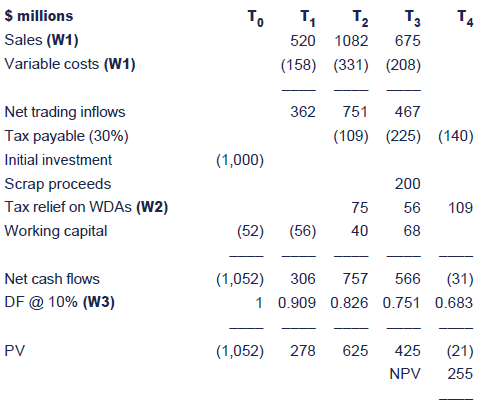
Working
Fixed cost = $8,000
Variable cost = 200 × $40 = $8,000
Total cost = fixed cost + variable cost = $8,000 + $8,000 = $16,000


 Test your understanding 8
Test your understanding 8
Consider the linear function y = 1,488 + 20x and answer the following questions.
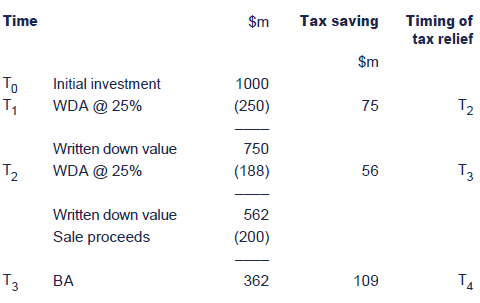


 Test your understanding 9
Test your understanding 9
If the total cost of a product is given as:
Y = 4,800 + 8x


6 Cost objects, cost units and cost centres
Analysing costs
Management will require a variety of different cost summaries, including:
- costs for a particular product – cost unit or cost object
- costs for use in the preparation of external financial reports
- costs for a particular department – cost centre
- costs that may be useful for decision making
- costs that are useful for planning and control.
Cost objects
 A cost object is any activity for which a separate measurement of cost is undertaken.
A cost object is any activity for which a separate measurement of cost is undertaken.
Examples of cost objects:
- cost of a product
- cost of a service (e.g. insurance policy)
- cost of running a department
- cost of running a regional office.
Cost units
A cost unit is a unit of product or service in relation to which costs are ascertained.
Examples of cost units:
- a room (in a hotel)
- a litre of paint (paint manufacturers)
- in-patient (in a hospital).
Cost centres
A cost centre is a production or service location, function, activity or item of equipment for which costs can be ascertained.
Examples of cost centres:
- a department
- a machine
- a project
- a ward (in a hospital).
Cost cards
The following costs are brought together and recorded on a cost card:
- direct materials
- direct labour
- direct expenses
- prime cost (total direct costs)
- variable production overheads
- fixed production overheads
- non-production overheads.

 Illustration 5 – Cost objects, cost units and cost centres
Illustration 5 – Cost objects, cost units and cost centres
A cost card for a hand-made wooden train set is shown below.
- The cutting and assembly department and the painting department are cost centres.
- One hand-made wooden train set is a cost unit (but may also be classed as a cost object).


7 Cost coding
Cost accountants need to determine the costs that relate to eachcost centre. To make this simpler each expense is classified accordingto its cost centre and type of expense. A cost code is then allocated tothe expense to represent this classification.
 A code is a system of letters/numbers designed to be applied to aclassified set of item, to give a brief accurate reference, which helpsentry to the records, collation and analysis.
A code is a system of letters/numbers designed to be applied to aclassified set of item, to give a brief accurate reference, which helpsentry to the records, collation and analysis.
The main purpose of cost codes is to:
- Assist precise information
- Facilitate data processing
- Facilitate logical arrangement of records
- Simplify comparisons of similar expenses
- Incorporate checking for accuracy
There are no set methods for designing a cost code, theorganisation will decide on the most appropriate coding system for theirbusiness.

 Illustration
Illustration
Suppose that the cost coding system for the JJ Ltd the shirt manufacturer is as follows:
Production cost centre
1 Cutting department
2 Sewing department
3 Pressing department
4 Packaging department
Non Production cost centres
5 Stores department
6 Maintenance department
7 Administration department
8 Selling & Marketing department
Cost code
15 Production labour
16 Production materials
17 Production expenses
18 Non-production labour
19 Non-production materials
20 Non-production expenses
The following invoices would be coded as:


8 Chapter summary
Test your understanding answers

 Test your understanding 1
Test your understanding 1



 Test your understanding 2
Test your understanding 2
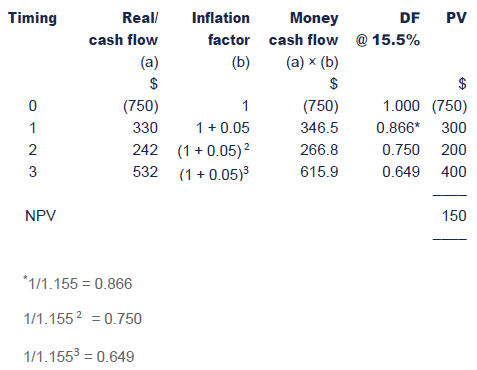


 Test your understanding 3
Test your understanding 3
(a) B Store assistants are not directly involved in producing the output (goods or services) of an organisation.
(b) B This is a basic definition question. Direct costs are costs which can be identified with a single cost unit, or cost centre.


 Test your understanding 4
Test your understanding 4
The items of expenditure would be analysed as follows.
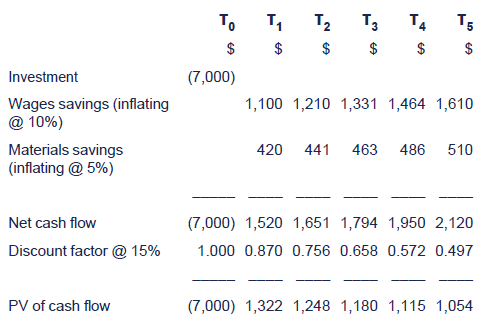
Note that the depreciation charge for the factory machines (8) is astepped fixed cost because as activity increases to such a level that asecond and third machine are required, the fixed cost will double andthen treble.


 Test your understanding 5
Test your understanding 5
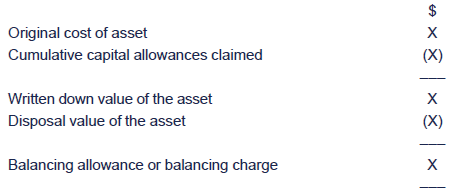


 Test your understanding 6
Test your understanding 6
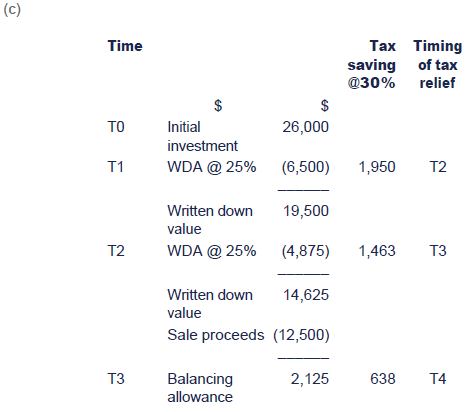


 Test your understanding 7
Test your understanding 7



 Test your understanding 8
Test your understanding 8



 Test your understanding 9
Test your understanding 9

Working
Fixed cost = $4,800
Variable cost = 100 x $8 = $800
Total cost = fixed cost + variable cost = $4,800 + $800 = $5,600

|
Created at 5/24/2012 5:06 PM by System Account
(GMT) Greenwich Mean Time : Dublin, Edinburgh, Lisbon, London
|
Last modified at 5/25/2012 12:53 PM by System Account
(GMT) Greenwich Mean Time : Dublin, Edinburgh, Lisbon, London
|
|
|
|
 |
Rating
:
|
 Ratings & Comments
(Click the stars to rate the page) Ratings & Comments
(Click the stars to rate the page)
|
 |
Tags:
|
|
|
|
|